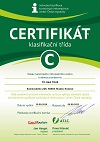Walking Tour I. | Walking Tour II. | Giant Aquarium | Botanical Garden of Medical Plants | Museum of Aviation | Labe Steamers | Autocamping Silver Pond
Walking Tour II.
Grey stands
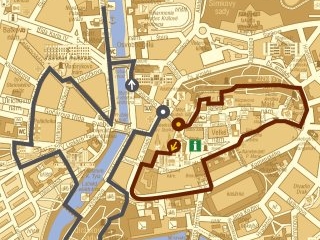 Tour no 2 includes eleven stops in the modern part of the city.
Tour no 2 includes eleven stops in the modern part of the city. It starts at the Museum of Eastern Bohemia, continues across Tyrš Bridge to the former Novák’s Garages, along the riverbank downstream the Labe River to Svoboda Square. From here, the tour leads through the pedestrian zone to Masaryk Square, and then to Ulrich Square. Going past Priest Ambrož’s Congregation it continues to Tyl’s Riverbank with Gočár’s school buildings. Across the river, past Sander’s power station at the Labe River the tour brings you to Jirásek’s Gardens to the place where Labe and Orlice come together. In the gardens the tour goes past the Eastern Orthodox Church of St. Nicholas and the remains of the military fortification. The walk ends at the old Adalbertinum in the avenue Československé armády.
9. Museum of Eastern Bohemia
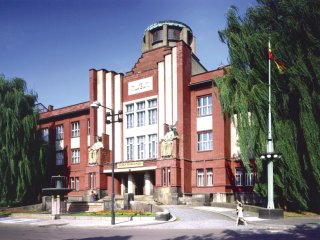 The monumental building of the museum on the city’s riverbank was
realised according to the project of the architect Jan Kotěra in 1909 - 1912.
It became the symbol of the oncoming period of Czech modernism.
Major Czech artists such as the sculptor Vojtěch Sucharda, painters František
Kysela and Jan Preisler participated in the decoration of the museum.
The monumental building of the museum on the city’s riverbank was
realised according to the project of the architect Jan Kotěra in 1909 - 1912.
It became the symbol of the oncoming period of Czech modernism.
Major Czech artists such as the sculptor Vojtěch Sucharda, painters František
Kysela and Jan Preisler participated in the decoration of the museum.
For its undoubted architectonic and artistic qualities the museum was designated a listed building - the only one in Hradec Králové.
Two models of Hradec Králové may be of particular interest to the visitors of the museum. So-called Žaloudek’s model shows the city at the time when it still was a military stronghold. The model from 2000 was designed in the model laboratory of the Faculty of Architecture in Prague.The vast collections of the museum include for example a decorated belt from the 15th century, which the legend ascribes to Eliška Pomořanská, or the remains of a mammoth in the archaeological collections. The part of the exhibitions related to technology shows for example the old automobile Start, one of the last models produced in Hradec Králové. In fact, the museum itself is a magnificent architectonic work of art. The collections introducing the work of Jan Kotěra and Hradec Králové, so-called “Salon of the Republic”, rank among the real jewels of the museum.
Address : Eliščino nábřeží 465
Contact : Eliščino nábřeží 465, 500 01, Hradec Králové phone: +420 495 512 391, www.muzeumhk.cz
10. City Spa - Aquacentrum
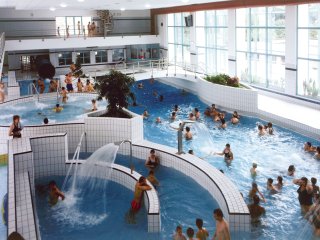 The City Spa on Eliščino nábřeží (Eliška’s riverbank) belongs to the best
works of architect Oldřich Liska. The functionalist construction was built
in 1933. With its thirty-meter swimming pool and simulated waves the spa
became the most modern indoor pool in the Czech Republic.
The City Spa on Eliščino nábřeží (Eliška’s riverbank) belongs to the best
works of architect Oldřich Liska. The functionalist construction was built
in 1933. With its thirty-meter swimming pool and simulated waves the spa
became the most modern indoor pool in the Czech Republic. The building is a part of the urban collection of buildings on the Labe riverbank which includes the building of Commercial Bank (architect J. Rejchl, 1933) or the Sokol Hall by architect M. Babuška. In the right wing of the Sokol Hall Hradec Králové Philharmonic is based. Between 1997 and 1999, a complete reconstruction of the City Spa was carried out, the spa was enlarged and the aquapark with many attractions was built.
Address : Eliščino nábřeží 842
Contact : Eliščino nábřeží 842, 500 01, Hradec Králové phone: +420 495 404 444, www.snhk.cz
11. Novák’s Garages
 The palace of garages by engineer Novák, Hradec Králové’s pioneer
of car industry is an example of flawless cooperation of the architect and
the builder. The palace was built in 1932. The revolutionary conception
of this monumental construction with a hundred and fifty parking places
was designed by the architect Josef Fňouk. The six-metre broad spiral
ramp that passes through the centre of the building constitutes the dominant
feature of the palace. On the roof it is covered by a marked cupola.
The descendants of engineer Novák renovated the building according
to the original project and it now serves the same purpose as before.
The palace of garages by engineer Novák, Hradec Králové’s pioneer
of car industry is an example of flawless cooperation of the architect and
the builder. The palace was built in 1932. The revolutionary conception
of this monumental construction with a hundred and fifty parking places
was designed by the architect Josef Fňouk. The six-metre broad spiral
ramp that passes through the centre of the building constitutes the dominant
feature of the palace. On the roof it is covered by a marked cupola.
The descendants of engineer Novák renovated the building according
to the original project and it now serves the same purpose as before.12. Masaryk Square
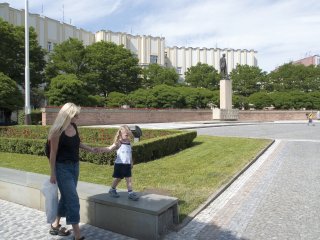 After Ulrich Square, Masaryk Square, situated among blocks of houses
away from the traffic, is the second most important open space in the modern
part of Hradec Králové. It has a triangular plan and the facade of constructions
by Josef Gočár (1922) at its northwest end form the characteristic feature
of the square. In 1926, the monument of president T. G. Masaryk by Otto
Gutfreund, renowned Czech sculptor, was placed in front of this dominant
architectonic setting. Thus the square became a place for peaceful contemplation
as well. In 2002, the square became a part of the pedestrian zone
that starts at Baťka Square and runs through the adjacent Čelakovský and
Švehla streets. Walking through the pedestrian zone, you may admire many
other interesting buildings such as the dwelling house by architect V. Fultner
(1912), former Carda’s bakery by architect B. Waigant (1912) or the house
of the Nevyhoštěný Company by architect O. Liska (1914).
After Ulrich Square, Masaryk Square, situated among blocks of houses
away from the traffic, is the second most important open space in the modern
part of Hradec Králové. It has a triangular plan and the facade of constructions
by Josef Gočár (1922) at its northwest end form the characteristic feature
of the square. In 1926, the monument of president T. G. Masaryk by Otto
Gutfreund, renowned Czech sculptor, was placed in front of this dominant
architectonic setting. Thus the square became a place for peaceful contemplation
as well. In 2002, the square became a part of the pedestrian zone
that starts at Baťka Square and runs through the adjacent Čelakovský and
Švehla streets. Walking through the pedestrian zone, you may admire many
other interesting buildings such as the dwelling house by architect V. Fultner
(1912), former Carda’s bakery by architect B. Waigant (1912) or the house
of the Nevyhoštěný Company by architect O. Liska (1914).13. Ulrich Square
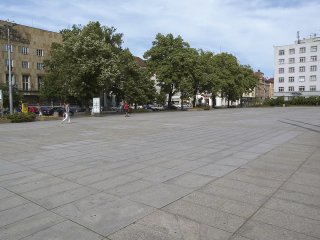 According to the regulation plan, Ulrich Square was supposed to become
the modern centre of the city. Architect Josef Gočár laid out its urbanistic
and architectonic composition and designed monumental rectangular space.
According to the regulation plan, Ulrich Square was supposed to become
the modern centre of the city. Architect Josef Gočár laid out its urbanistic
and architectonic composition and designed monumental rectangular space.
At places where Gočár’s avenue enters the square, four corner buildings which are two floors higher that the surrounding houses create symbolic gates to the square. The south end of the square is occupied by the former seat of the National Railway Headquarters by architect Gočár. Today it is the seat of the Czech Police and many other offices. The opposite end is dominated by a monumental palace, formerly the seat of factory owner Steinský-Sehnoutka (architect O. Novotný, 1929), today the seat of the bank ČSOB.
14. Priest Ambrož’s Congregation of the Czechoslovak Hussite Church
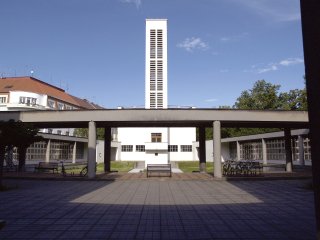 Priest Ambrož’s Congregation is another outstanding construction by
architect Josef Gočár. During 1926 - 1929 the church with 26.5 meter high
white prismatic tower was built according to his project together with the
school complex on the right side of the Labe River basin. The constructionist
buildings of the church are situated on a triangular estate. The main
entrance with the view of the atrium and church tower is between two onestory
buildings. The ambit around the atrium creates a columbarium that
unites all the buildings into one complex. The constructions are concrete
and the facades combine fair-faced brickwork with white plaster. Priest
Ambrož’s Congregation has recently gone through a thorough reconstruction,
which made it possible to use the building not only for the purposes
of the church, but also for cultural events, mainly art exhibitions.
Priest Ambrož’s Congregation is another outstanding construction by
architect Josef Gočár. During 1926 - 1929 the church with 26.5 meter high
white prismatic tower was built according to his project together with the
school complex on the right side of the Labe River basin. The constructionist
buildings of the church are situated on a triangular estate. The main
entrance with the view of the atrium and church tower is between two onestory
buildings. The ambit around the atrium creates a columbarium that
unites all the buildings into one complex. The constructions are concrete
and the facades combine fair-faced brickwork with white plaster. Priest
Ambrož’s Congregation has recently gone through a thorough reconstruction,
which made it possible to use the building not only for the purposes
of the church, but also for cultural events, mainly art exhibitions.Address : Ambrožova St 728-729
Contact : Sbor CČH kněze Ambrože (Priest Ambrož’s Congregation), Ambrožova 728, 500 02 Hradec Králové, phone: +420 495 511 067, www.ccshhk.cz
15. School Complex in Lipky
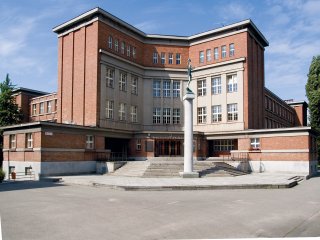 Kotěra’s student at the Academy of Arts, Design and Architecture architect
Josef Gočár, later the professor and rector of the school, reached
remarkable achievements in the area of urban planning. Many of them are
found in Hradec Králové: the unique regulation plan of the city, the staircase
Na Kropáčce, the adaptation of Masaryk Square and other projects. Gočár’s
conception of the school complex on today’s Tylovo nábřeží (Tyl’s riverbank)
is equally remarkable.
Kotěra’s student at the Academy of Arts, Design and Architecture architect
Josef Gočár, later the professor and rector of the school, reached
remarkable achievements in the area of urban planning. Many of them are
found in Hradec Králové: the unique regulation plan of the city, the staircase
Na Kropáčce, the adaptation of Masaryk Square and other projects. Gočár’s
conception of the school complex on today’s Tylovo nábřeží (Tyl’s riverbank)
is equally remarkable. Previously Rašín’s, at present Tyl’s Grammar School was built in 1925 - 1927. This complex includes the school building, gym and the headmaster’s villa. In front of the entrance to the complex, there is a six-metre bronze statue of the Victor by Jan Štursa, one of the founders of Czech modern sculpture. The statue was placed here after it had been displayed at the World Exhibition in Paris so as the state symbol of the Czechoslovakia by Otto Gutfreund dated 1925 - 1927 on the south wing of the building. Next to the grammar school, Gočár placed the primary and junior high schools, at present Tylovo nábřeží (Tyl’s riverbank) Primary School and a kindergarten.
16. Labe River Power Station
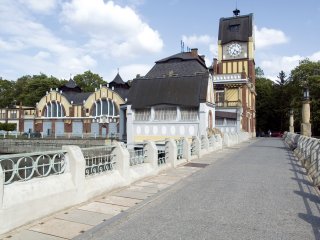 The Labe River power station is one of the most beautiful Art Nouveau
buildings in the city. It was built in 1910 - 1912 according to the project
of architect F. Sander on the place of an old weir, called Hučák. However,
the construction was fully completed only after the First World War. It is
a unique and still functional technical construction.
The Labe River power station is one of the most beautiful Art Nouveau
buildings in the city. It was built in 1910 - 1912 according to the project
of architect F. Sander on the place of an old weir, called Hučák. However,
the construction was fully completed only after the First World War. It is
a unique and still functional technical construction. The two-wing building is dominated by a clock tower with a relief symbol of the city in the plaster. The bridge at the station is five metres wide and fifty-six metres long. On the pillars street lighting poles are placed and there are also kiosks with the facilities to control the weir. In 1996, the complete reconstruction of the power station and the bridge was completed. The construction is lighted, and they look impressive even at night.
17. Jirásek’s Gardens
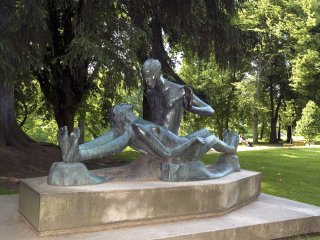 The gardens, originally officers’ gardens at the time of the military
stronghold, are situated on a triangular area bounded by the confluence
of the Labe and Orlice rivers. In the gardens you will find a number
of rare tree species. Numerous kinds of flowers bloom here in summer creating
manifold colour variations and smelling beautifully. This is also why
the park is popular with people in love.
The gardens, originally officers’ gardens at the time of the military
stronghold, are situated on a triangular area bounded by the confluence
of the Labe and Orlice rivers. In the gardens you will find a number
of rare tree species. Numerous kinds of flowers bloom here in summer creating
manifold colour variations and smelling beautifully. This is also why
the park is popular with people in love. In the gardens, there is a monument to the writer Alois Jirásek, and a sculpture by J. Škoda depicting the confluence of the Labe River with the Orlice River. You can see a number of attractions in the gardens, such as the fortification gate, and you can also visit St. Nicholas Church, which was transported here from Eastern Slovakia. It is possible to get to the park from Komenský or Křižík streets.
18. St. Nicholas Church
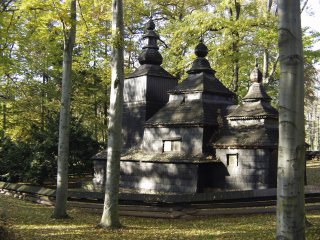 St. Nicholas’s Church in Jirásek’s Gardens is an interesting example
of wooden vernacular architecture. Originally, the church was built in
1502 - 1510 in the Habura town near Mezilaborce in Eastern Slovakia.
In 1740, it was sold to Malá Polana, where it was converted to a Greek-
Catholic Church of St. Nicholas-the Wondermaker. In 1935, the church was
purchased for Hradec Králové thanks to the efforts of Mayor Josef V. B. Pilnáček.
It was renovated expensively and situated into Jirásek’s Gardens.
The church is surrounded by the authentic fence. In the church interiors
your attention will be drawn to a well-preserved iconostas, twelve arm
chandelier and other items of indoor decoration.
St. Nicholas’s Church in Jirásek’s Gardens is an interesting example
of wooden vernacular architecture. Originally, the church was built in
1502 - 1510 in the Habura town near Mezilaborce in Eastern Slovakia.
In 1740, it was sold to Malá Polana, where it was converted to a Greek-
Catholic Church of St. Nicholas-the Wondermaker. In 1935, the church was
purchased for Hradec Králové thanks to the efforts of Mayor Josef V. B. Pilnáček.
It was renovated expensively and situated into Jirásek’s Gardens.
The church is surrounded by the authentic fence. In the church interiors
your attention will be drawn to a well-preserved iconostas, twelve arm
chandelier and other items of indoor decoration.Projekt je podporován Královéhradeckým krajem.

